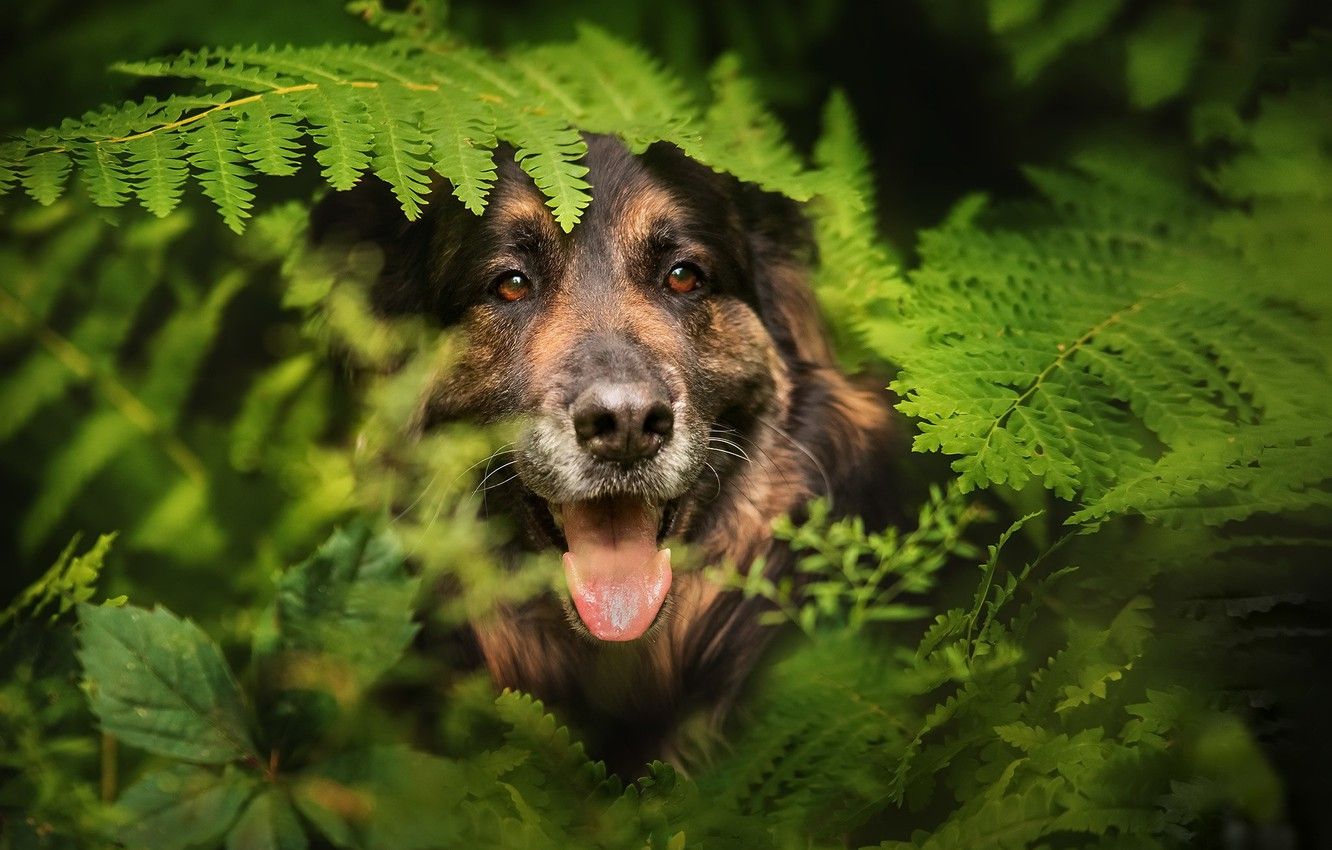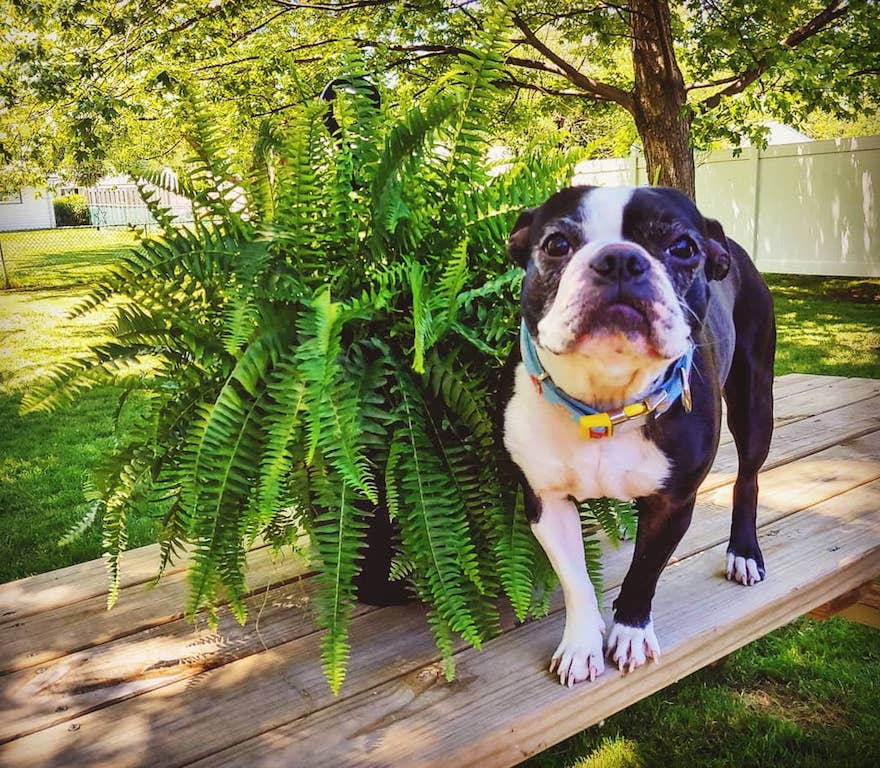Ferns are a popular choice for indoor and outdoor plants due to their beautiful foliage and low maintenance requirements. However, it is important for dog owners to be aware of the potential dangers that ferns can pose to their furry friends. The main concern when it comes to ferns and dogs is their potential toxicity.

While not all ferns are poisonous to dogs, there are certain types that can be harmful if ingested. It is crucial to identify which ferns are toxic to dogs to ensure the safety of your pet. The specific toxins present in ferns that can harm dogs vary depending on the species. Some ferns contain chemicals such as thiaminase, ptaquiloside, and glycosides, which can have detrimental effects on a dog's health if consumed.
If a dog ingests a poisonous fern, it can lead to various symptoms and health problems. Immediate symptoms may include vomiting, diarrhea, drooling, and abdominal pain. Delayed symptoms can manifest as kidney damage, liver failure, seizures, and even death in severe cases. Recognizing the signs and symptoms of fern poisoning in dogs is essential for prompt intervention and treatment. Keep an eye out for immediate symptoms such as gastrointestinal distress, as well as delayed symptoms that indicate potential organ damage or toxicity.

If your dog has ingested a fern and you suspect fern poisoning, it is crucial to seek veterinary assistance immediately. Contact your veterinarian or an animal poison control hotline for guidance on what steps to take and how to mitigate the effects of the fern's toxins on your dog's health. Prevention is key when it comes to protecting your happy dog from fern poisoning. Keep ferns out of your dog's reach, whether they are indoor or outdoor plants.
If you have a dog-friendly home or garden, consider opting for non-toxic plants as alternatives to ferns to ensure a safe and pet-friendly environment. By understanding the potential risks and taking appropriate measures to prevent fern poisoning in dogs, you can help keep your furry friend safe and healthy.
Key takeaways:
- Some ferns are poisonous to dogs: Certain types of ferns contain toxins that can harm dogs if ingested, so it's important to be aware of which fern species are dangerous.
- Symptoms of fern poisoning in dogs: Immediate symptoms of fern poisoning may include vomiting, diarrhea, and lethargy, while delayed symptoms can range from liver damage to kidney failure.
- Prevention and action: To prevent fern poisoning, keep ferns out of reach from dogs and consider using non-toxic plants for dog-friendly landscaping. If your dog ingests a fern, seek veterinary attention immediately.
Are Ferns Poisonous to Dogs?
Ferns can indeed be toxic to dogs if ingested. As responsible pet owners, it is crucial to be aware of the potential dangers associated with ferns and to take necessary precautions in order to keep our furry friends safe. Certain species of ferns may contain substances that can lead to digestive upset, diarrhea, or even more severe health issues in dogs. If you suspect that your dog has consumed a toxic plant, it is always advisable to consult with a veterinarian for proper guidance. To ensure the well-being of our dogs, pet owners should consider either keeping ferns out of their reach or opting for pet-friendly plants instead.
What Types of Ferns are Poisonous to Dogs?
Some types of ferns can be poisonous to dogs if ingested. Ferns that are toxic to dogs include weeping fig, plumosa fern, emerald feather, racemose asparagus, and sprengeri fern. These ferns contain specific toxins that can harm dogs, such as cytotoxic saponins. If a dog ingests a poisonous fern, they may experience symptoms like stomach pain, vomiting, increased salivation, skin irritation, and dilated pupils. It's important for dog owners to be aware of these risks and prevent their pets from accessing these toxic plants. If a dog ingests a poisonous fern, immediate medical attention should be sought.
What are the Specific Toxins in Ferns that can Harm Dogs?
Ferns contain several toxins that can be harmful to dogs if ingested. Some specific toxins found in ferns include saponins, which can cause gastrointestinal irritation and damage to red blood cells; oxalates, which can cause oral irritation and difficulty swallowing; and calcium oxalate crystals, which can cause irritation and inflammation of the skin and mucous membranes. These toxins can lead to symptoms such as vomiting, diarrhea, loss of appetite, drooling, and skin irritation. It is important to seek immediate veterinary attention if you suspect your dog has ingested a toxic fern.
Story: A dog owner named Sarah unknowingly had a toxic fern in her backyard. One day, her curious dog, Max, ingested some leaves from the fern. Max soon started vomiting and had diarrhea. Concerned, Sarah rushed Max to the veterinarian, who identified the fern as toxic and administered appropriate treatment. This true story highlights the importance of being aware of the specific toxins in ferns and taking prompt action to protect our furry friends.
What Happens if a Dog Ingests a Poisonous Fern?
When a dog ingests a poisonous fern, it can lead to various adverse effects on their health. The specific toxins in ferns can cause symptoms such as stomach pain, increased salivation, appetite loss, and skin irritation. In severe cases, ingestion of a poisonous fern can even lead to more serious conditions like skin inflammation, dilated pupils, and damage to red blood cells. If a dog ingests a poisonous fern, it is crucial to seek immediate veterinary attention. The vet may induce vomiting, perform a physical examination, and administer activated charcoal to help eliminate the toxins from the dog's system. Remember to keep toxic ferns out of reach of dogs and consider using alternative non-toxic plants for dog-friendly landscaping.

Signs and Symptoms of Fern Poisoning in Dogs
Recognizing the signs and symptoms of fern poisoning in dogs is crucial for their well-being.
- One of the most common signs, dogs may vomit repeatedly after ingesting ferns.
- Diarrhea: Fern ingestion can lead to diarrhea in dogs, which may be frequent and watery.
- Abdominal pain: Dogs may exhibit signs of discomfort in the abdomen, such as restlessness or reluctance to lie down.
- Lethargy: A dog with fern poisoning may appear weak, tired, and lacking energy.
- Loss of appetite: The dog may show a decreased interest in food or refuse to eat altogether.
Pro-tip: If you suspect fern poisoning in your dog, contact a veterinarian immediately for proper diagnosis and treatment.
What are the Immediate Symptoms of Fern Poisoning?
Immediate symptoms of fern poisoning in dogs can vary depending on the specific type of fern ingested. Common immediate symptoms, including vomiting, diarrhea, and drooling, can be observed. Dogs may also exhibit signs of abdominal pain, such as restlessness or an arched back. Other possible immediate symptoms that can occur are increased salivation, appetite loss, and dilated pupils. It is important to note that if a dog comes into contact with the plant, fern poisoning can cause more severe symptoms such as skin irritation or inflammation. If you suspect your dog has ingested a poisonous fern, it is essential to seek immediate veterinary attention to ensure proper treatment and prevent further complications.
What are the Delayed Symptoms of Fern Poisoning?
Delayed symptoms of fern poisoning in dogs may appear hours or days after ingestion. These symptoms, which include vomiting, diarrhea, dehydration, weakness, lack of appetite, and lethargy, can be a cause for concern. Additionally, dogs may experience abnormal bleeding, jaundice, dark-colored urine, and pale gums. If you notice any of these signs in your dog, it is crucial to seek immediate veterinary attention. Treatment options may involve fluid therapy, activated charcoal administration, supportive care, and the use of specific antidotes, if available. To prevent fern poisoning, it is essential to keep toxic ferns out of your dog's reach and consider dog-friendly alternatives when it comes to landscaping. Prompt action is key in order to prevent further complications and ensure the well-being of your beloved pet.
Fact: It is important to note that certain ferns, such as the asparagus fern, contain chemicals that can irritate the skin and lead to allergic dermatitis in dogs.
What to Do if Your Dog Ingests a Fern?
If your dog ingests a fern, it is important to know what to do to ensure their safety. Here are the steps you can follow if your dog ingests a fern:
1. Identify the fern: Determine the specific type of fern your dog ingested to determine its potential toxicity levels.
2. Contact a veterinarian: Reach out to your vet and provide them with all the relevant information about the fern and your dog's condition.
3. Observe your dog: Keep an eye out for symptoms such as vomiting, diarrhea, excessive drooling, or lethargy.
4. Follow your vet's guidance: Your vet may recommend inducing vomiting, administering activated charcoal, or scheduling a visit to the clinic.
Let me share a true story: One day, my curious dog ingested a fern from our backyard. I immediately reached out to our veterinarian, who guided me through the necessary steps to ensure my dog's well-being. Following their instructions, I induced vomiting and closely monitored my dog. Thanks to quick action and professional guidance, my furry friend recovered without any complications. Always remember to consult a veterinarian if your dog ingests any potentially harmful substance.

Prevention of Fern Poisoning in Dogs
To ensure the prevention of fern poisoning in dogs, it is important to follow these steps:
- Keep ferns out of reach: Place ferns in areas that are inaccessible to dogs, such as high shelves or hanging baskets.
- Utilize deterrents: Sprinkle bitter apple spray or other pet-safe deterrents on fern leaves to discourage dogs from chewing on them.
- Train your dog: Teach your dog the "leave it" command to prevent them from eating or chewing on ferns.
- Supervise outdoor time: Maintain vigilance over your dog when they are outside to make sure they do not come into contact with toxic ferns.
- Seek veterinary advice: If you suspect that your dog has consumed a toxic fern, immediately contact your veterinarian for guidance.
How to Keep Ferns Out of Reach for Dogs?
To keep ferns out of reach for dogs, here are some simple steps you can follow:
- Elevate ferns: Place potted ferns on high shelves or hanging baskets to prevent dogs from accessing them.
- Create barriers: Use pet gates or fences to block off areas where ferns are kept.
- Train your dog: Teach your dog to stay away from plants by using commands and positive reinforcement.
- Choose dog-friendly plants: Opt for non-toxic plants like spider plants or Boston ferns that won't harm your dog if ingested.
- Supervise outdoor activities: Keep a close eye on your dog when they are outside to prevent them from chewing on ferns.
By following these steps, you can ensure that your dog stays safe and ferns remain out of their reach. Remember, prevention is key to keeping your furry friend healthy and happy.
Alternative Non-Toxic Plants for Dog-Friendly Landscaping
Choosing alternative non-toxic plants for dog-friendly landscaping is essential in ensuring the safety and well-being of our furry friends. Here are some options to consider for creating a dog-friendly garden:
- 1. Marigolds: These colorful flowers, which are part of alternative non-toxic plants for dog-friendly landscaping, not only add beauty to your garden but also repel pests.
- 2. Sunflowers: These cheery blooms, considered part of alternative non-toxic plants for dog-friendly landscaping, can brighten up your garden and are completely safe for dogs.
- 3. Rosemary: This aromatic herb, an example of alternative non-toxic plants for dog-friendly landscaping, can be utilized in cooking while ensuring the safety of your furry friends.
- 4. Petunias: These vibrant flowers, a fantastic addition to any garden and an alternative non-toxic plant for dog-friendly landscaping, pose no harm to dogs.
- 5. Ferns: While it's important to check the toxicity of certain fern species, there are alternative non-toxic plants for dog-friendly landscaping like the Boston fern that add a lush green look to your landscape without endangering your beloved pets.
Remember to always double-check the toxicity of any plant before adding it to your dog-friendly garden.

Frequently Asked Questions
Are ferns poisonous to dogs?
According to the ASPCA, most true ferns, such as sword fern, button fern, and mother fern, are considered non-toxic to dogs.
What are the symptoms of fern poisoning in dogs?
The symptoms of fern poisoning in dogs may include vomiting, diarrhea, abdominal pain, and skin irritation.
How can fern poisoning in dogs be diagnosed?
To diagnose fern poisoning in dogs, a veterinarian may perform a complete physical examination, bloodwork, urinalysis, biochemistry profile, and tests on vomit and stool contents for the presence of toxins.
What is the treatment for fern poisoning in dogs?
The treatment for fern poisoning in dogs may include decontamination, such as rinsing the mouth and washing exposed skin, inducing vomiting, and administering activated charcoal to prevent toxin absorption.
Are asparagus ferns toxic to dogs?
Yes, asparagus ferns are highly toxic to both cats and dogs. Ingesting their leaves and berries can cause vomiting, diarrhea, stomach pain, and skin inflammation.
How can I prevent fern poisoning in my dog?
To prevent fern poisoning in dogs, it is best to keep ferns out of their reach by placing them in hanging planters or on high shelves. It is also advisable to avoid bringing toxic plants into the home.




